《电路》课程实验教学大纲 Experiment of Electric Circuit A
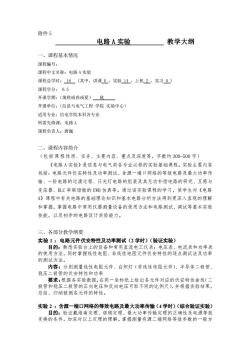
附件5 电路A实验 教学大纲 一、课程基本情况 课程编号: 课程中文名称:电路A实验 课程总学时:16(其中,讲课0,实验14,上机2,实习0) 课程学分:0.5 开课学期:(填秋或春或夏)秋 开课单位:(信息与电气工程学院实验中心) 适用专业:信电学院本科各专业 所需先修课:电路A 课程负责人:唐巍 二、课程内容简介 (包括课程性质、任务、主要内容、重点及深度等,字数约300-500字) 《电路A实验》是信息与电气类各专业必修的实验基础课程。实验主要内容 包括:电路元件伏安特性及功率测试、含源一端口网络的等效电路及最大功率传 输、一阶电路的过渡过程、日光灯电路的组装及其无功补偿电路的研究、互感与 变压器、RLC串联谐振的EWB仿真等。通过该实验课程的学习,使学生对《电路 A》课程中有关电路的基础理论知识和基本电路分析方法得到更深入直观的理解 和掌握,掌握电路中常用仪器测量设备的使用方法和电路测试、调试等基本实验 技能,以及初步的电路设计实验能力。 三、各部分教学纲要 实验1:电路元件伏安特性及功率测试(2学时)(验证实验) 目的:熟悉实验台上的设备和常用直流电工仪表:电压表、电流表和功率表 的使 法,同时掌握线性电阻、非线性电阻元件伏安特性的逐点测试法及功率 的测试方法。 内容:分别测量线性电阻元件、白炽灯(非线性电阻元件)、半导体二极管。 稳压二极管的代安特性和功率 要求:根据名实验数据在同一坐标纸上绘出名元件对应的伏安特性曲线(二 极管和稳压二极管的正 向电压和反向电压可取不同的比例尺),并根据实验结果, 总结、归纳被测各元件的特性 实验2:含源一端口网络的等效电路及最大功率传输(4学时)(综合验证实验) 目的:验证戴维南定理、诺顿定理、最大功率传输定理的正确性及电源等效 变换的条件,加深对以上定理的理解。掌握测量有源二端网络等效参数的一般方
附件 5 电路 A 实验 教学大纲 一、课程基本情况 课程编号: 课程中文名称:电路 A 实验 课程总学时: 16 (其中,讲课 0 ,实验 14 ,上机 2 ,实习 0 ) 课程学分: 0.5 开课学期:(填秋或春或夏) 秋 开课单位:(信息与电气工程 学院 实验中心) 适用专业:信电学院本科各专业 所需先修课:电路 A 课程负责人:唐巍 二、课程内容简介 (包括课程性质、任务、主要内容、重点及深度等,字数约 300-500 字) 《电路 A 实验》是信息与电气类各专业必修的实验基础课程。实验主要内容 包括:电路元件伏安特性及功率测试、含源一端口网络的等效电路及最大功率传 输、一阶电路的过渡过程、日光灯电路的组装及其无功补偿电路的研究、互感与 变压器、RLC 串联谐振的 EWB 仿真等。通过该实验课程的学习,使学生对《电路 A》课程中有关电路的基础理论知识和基本电路分析方法得到更深入直观的理解 和掌握,掌握电路中常用仪器测量设备的使用方法和电路测试、调试等基本实验 技能,以及初步的电路设计实验能力。 三、各部分教学纲要 实验 1 :电路元件伏安特性及功率测试(2 学时)(验证实验) 目的:熟悉实验台上的设备和常用直流电工仪表:电压表、电流表和功率表 的使用方法,同时掌握线性电阻、非线性电阻元件伏安特性的逐点测试法及功率 的测试方法。 内容:分别测量线性电阻元件、白炽灯(非线性电阻元件)、半导体二极管、 稳压二极管的伏安特性和功率 要求:根据各实验数据,在同一坐标纸上绘出各元件对应的伏安特性曲线(二 极管和稳压二极管的正向电压和反向电压可取不同的比例尺),并根据实验结果, 总结、归纳被测各元件的特性。 实验 2 :含源一端口网络的等效电路及最大功率传输(4 学时)(综合验证实验) 目的:验证戴维南定理、诺顿定理、最大功率传输定理的正确性及电源等效 变换的条件,加深对以上定理的理解。掌握测量有源二端网络等效参数的一般方
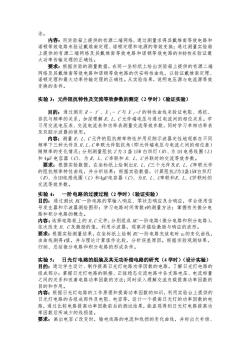
法。 内容:用实验箱上提供的有源二瑞网络,诵讨测量求得其哉维南等效申路知 诺顿等效电路来验证戴维南定理、诺顿定理和电源的等效变换通过测量实验箱 上提供的有源二端网络及其戴维南等效电路和诺顿等效电路的外特性未验证最 大功率传输定理的正确性。 要求:根据实验的测量数据,在同一坐标纸上绘出实验箱上提供的有源二端 网络及其戴维南等效申路和诺场竿效申路的伏安特性曲线,以验证戴维南定理, 诺顿定理和最大功率传输定理的正确性。从实验结果,说明电压源与电流源等效 变换的条件。 实验3:元件阻抗特性及交流等效参数的测定(2学时)(验证实验) 目的:通过测定R一F、X,一f与X。-f的特性曲线来验证电阻、感抗 容抗与频率的关系,加深理解、L、C元件端电压与通过电流间的相位关系 习用交流电压表、交流电流表和功率表测量交流等效参数,同时学习单相功率表 及双踪示波器的使用。 内容:测量R、L、C元件的阻抗频率特性并用双踪示波器定性地观察在不同 频率下三种元件及R、L、C串联元件阻抗角(即元件端电压与电流之间的相位差) 随频率的变化情况:分别测量阻抗Z为3盏15W白炽灯()、为1H电感线圈(L) f和 4如F电容器(CO、为R、L、C串联和R 、C并联时的交流等效参数 要求:根据实验数据,在坐标纸上绘制出R、L、C三个元件及RL、C串联元件 的阻抗频率特性曲线,并分析结果;根据实验数据,计算阻抗Z为3盏15W白炽灯 (R)、为1H电感线圈(L)和4μF电容器(C)、为R、L、C串联和R、L、C并联时的 交流等效参数。 实验4: 一阶电路的过渡过程(2学时)(验证实验) 目的:通过测试℃一阶电路的零输入响应、零状态响应及全响应,学会使用信 号发生器和示波器测绘图形:学习电路时间常数的测量方法;掌握有关微分电 路和积分电路的概念。 内容:达择电路板上的R,C元件,分别组成心一阶电路(微分电路和积分电路” 示器 观察并描绘激励与响应的波形 要求:根据实验测量结果,在坐标纸上绘制RC一阶电路充放电时u的变化曲线, 由曲线测得值,并与理论计算值作比较,分析误差原因。根据实验观测结果, 归纳、总结微分电路和积分电路的形成条件。 实验5: 日光灯电路的组装及其无功补偿电路的研究(4学时)(设计实验) 目的:通过学生设计、制作提高日光灯电路功率因数的电路,了解日光灯电路的 组成部分;掌握日光灯电路的联接、正弦稳态交流电路中各支路电压、电流相量 之间的关系和改善电路功率因数的方法:同时深入理解交流负载提高功率因数的 目的和作用。 内容:根据日光灯电路的工作原理和提高功率因数的知识,利用实验台上提供的 日光灯电路的各组成部件及电阻、电容等,设计 提高日光灯的功率因数的 路,通过比较电路提高功率因数前后的测试结果,能直观得到日光灯电路提高功 率因数后所减少的线损值。 要求:画出申容C改变时,输申线路的申流和线损的变化曲线,并标出次补偿
法。 内容:用实验箱上提供的有源二端网络,通过测量求得其戴维南等效电路和 诺顿等效电路来验证戴维南定理、诺顿定理和电源的等效变换;通过测量实验箱 上提供的有源二端网络及其戴维南等效电路和诺顿等效电路的外特性来验证最 大功率传输定理的正确性。 要求:根据实验的测量数据,在同一坐标纸上绘出实验箱上提供的有源二端 网络及其戴维南等效电路和诺顿等效电路的伏安特性曲线,以验证戴维南定理、 诺顿定理和最大功率传输定理的正确性。从实验结果,说明电压源与电流源等效 变换的条件。 实验 3:元件阻抗特性及交流等效参数的测定(2 学时)(验证实验) 目的:通过测定 R - f 、X L - f 与 X C -f 的特性曲线来验证电阻、感抗、 容抗与频率的关系,加深理解 R、L、C 元件端电压与通过电流间的相位关系。学 习用交流电压表、交流电流表和功率表测量交流等效参数,同时学习单相功率表 及双踪示波器的使用。 内容:测量 R、L、C 元件的阻抗频率特性并用双踪示波器定性地观察在不同 频率下三种元件及 R、L、C 串联元件阻抗角(即元件端电压与电流之间的相位差) 随频率的变化情况;分别测量阻抗 Z 为 3 盏 15W 白炽灯(R)、为 1H 电感线圈(L) 和 4F 电容器(C)、为 R、L、C 串联和 R、L、C 并联时的交流等效参数。 要求:根据实验数据,在坐标纸上绘制出R、L、C三个元件及R、L、C串联元件 的阻抗频率特性曲线,并分析结果;根据实验数据,计算阻抗Z为3盏15W白炽灯 (R)、为1H电感线圈(L)和4F电容器(C)、为R、L、C串联和R、L、C并联时的 交流等效参数。 实验 4: 一阶电路的过渡过程(2 学时)(验证实验) 目的:通过测试 RC 一阶电路的零输入响应、零状态响应及全响应,学会使用信 号发生器和示波器测绘图形;学习电路时间常数的测量方法;掌握有关微分电 路和积分电路的概念。 内容:选择电路板上的 R、C 元件,分别组成 RC 一阶电路(微分电路和积分电路), 依次改变 R、C 及激励的值,利用示波器,观察并描绘激励与响应的波形。 要求:根据实验测量结果,在坐标纸上绘制 RC 一阶电路充放电时 uc的变化曲线, 由曲线测得值,并与理论计算值作比较,分析误差原因。根据实验观测结果, 归纳、总结微分电路和积分电路的形成条件。 实验 5: 日光灯电路的组装及其无功补偿电路的研究(4 学时)(设计实验) 目的:通过学生设计、制作提高日光灯电路功率因数的电路,了解日光灯电路的 组成部分;掌握日光灯电路的联接、正弦稳态交流电路中各支路电压、电流相量 之间的关系和改善电路功率因数的方法;同时深入理解交流负载提高功率因数的 目的和作用。 内容:根据日光灯电路的工作原理和提高功率因数的知识,利用实验台上提供的 日光灯电路的各组成部件及电阻、电容等,设计一个提高日光灯的功率因数的电 路,通过比较电路提高功率因数前后的测试结果,能直观得到日光灯电路提高功 率因数后所减少的线损值。 要求:画出电容 C 改变时,输电线路的电流和线损的变化曲线,并标出欠补偿
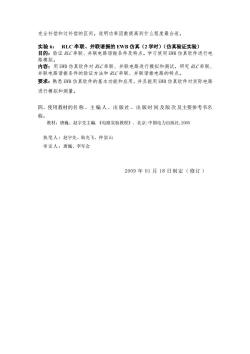
完全补偿和过补偿的区间。说明功率因数提高到什么程度最合适。 实验6:RLC串联、并联谐振的EWB仿真(2学时)(仿真验证实验) 目的:验证LC串联、并联电路谐振条件及特点。学习使用EWB仿真软件进行电 路模拟。 内容:用EWB仿真软件对LC串联、并联电路进行模拟和测试,研究LC串联 并联电路谐振条件的验证方法和LC串联、并联谱振电路的特点。 要求:熟悉EWB仿真软件的基本功能和应用,并且能用EWB仿真软件对实际电路 进行模拟和测量。 四、使用教材的名称、主编人、出版社、出版时间及版次及主要参考书名 称。 教材:唐类、赵宇先主编.《电路实验教程》.北京:中国电力出板社,2005 执笔人:赵字先、耿光飞、仲崇山 审定人:唐巍、李军会 2009年01月18日制定(修订)
完全补偿和过补偿的区间。说明功率因数提高到什么程度最合适。 实验 6: RLC 串联、并联谐振的 EWB 仿真(2 学时)(仿真验证实验) 目的:验证 RLC 串联、并联电路谐振条件及特点。学习使用 EWB 仿真软件进行电 路模拟。 内容:用 EWB 仿真软件对 RLC 串联、并联电路进行模拟和测试,研究 RLC 串联、 并联电路谐振条件的验证方法和 RLC 串联、并联谐振电路的特点。 要求:熟悉 EWB 仿真软件的基本功能和应用,并且能用 EWB 仿真软件对实际电路 进行模拟和测量。 四、使用教材的名 称 、主 编 人、出 版社 、出 版时 间 及版 次及主要参考书名 称。 教材:唐巍、赵宇先主编.《电路实验教程》. 北京:中国电力出版社,2005 执笔人:赵宇先、耿光飞、仲崇山 审定人:唐巍、李军会 2009 年 01 月 18 日制定( 修订 )
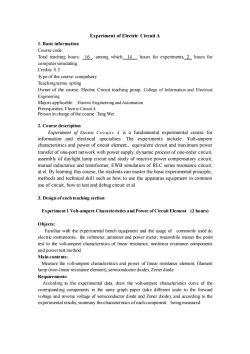
Experiment of Electric Circuit A 1.Basic information Course code Total teaching hours:16,among which 14 hours for experiments.2 hours for computer simulating Credits0 5 Type of the cours mpulsory Teaching terms:spring Owner of the course:Electric Circuit teaching group,College of Information and Electrical Engineering Majors applicable:Electric Engineering and Automation Prerequisites:Electric CircuitA Person in charge of the course:Tang Wei 2.Course deseription Experiment of Electric Circuits A is a fundamental experimental course for information and electrical specialties.The experiments include:Volt-ampere characteristics and power of circuit element,equivalent circuit and maximum power transfer of one-port network with power supply,dynamic process of one-order circuit assembly of daylight lamp circuit and study of reactive power compensatory circuit, mutual inductance and transformer,EWB simulation of RLC series resonance circuit, at el.By learning this course,the students can master the basic experimental principle, methods and technical skill such as how to use the apparatus equipment in common use of,how to test and et al. 3.Design ofeach teaching section Experiment 1 Volt-ampere Characteristics and Power of Circuit Element (2 hours) Objects Familiar with the experimental bench equipment and the usage of commonly used do electric instruments:the voltmeter,ammeter and power meter;meanwhile master the point test to the volt-ampere characteristics of linear resistance,nonlinear resistance components and power test method. Main contents: Measure the volt-ampere characteristics and power of linear resistance elment filament amp (non-linear resistance element),semiconductor diodes,Zener diode Requirements: According to the experimental data,draw the volt-ampere characteristics curve of the pondin ng compo nts in the pape nt scale to the forward voltage and e voltage of sem or diode ar Zener dio e),and according to the experimental results,summary the characteristics of each component being measured
Experiment of Electric Circuit A 1. Basic information Course code: Total teaching hours: 16 , among which 14 hours for experiments, 2 hours for computersimulating. Credits: 0.5 Type of the course: compulsory Teaching terms: spring Owner of the course: Electric Circuit teaching group, College of Information and Electrical Engineering Majors applicable: Electric Engineering and Automation Prerequisites: Electric Circuit A Person in charge of the course: Tang Wei 2. Course description Experiment of Electric Ci rcu it s A is a fundamental experimental course for information and electrical specialties. The experiments include: Volt-ampere characteristics and power of circuit element,equivalent circuit and maximum power transfer of one-port network with power supply, dynamic process of one-order circuit, assembly of daylight lamp circuit and study of reactive power compensatory circuit, mutual inductance and transformer, EWB simulation of RLC series resonance circuit, at el. By learning this course, the students can master the basic experimental principle, methods and technical skill such as how to use the apparatus equipment in common use of circuit, how to test and debug circuit et al. 3. Design of each teaching section Experiment 1 Volt-ampere Characteristics and Power of Circuit Element (2 hours) Objects: Familiar with the experimental bench equipment and the usage of commonly used dc electric instruments:the voltmeter, ammeter and power meter; meanwhile master the point test to the volt-ampere characteristics of linear resistance, nonlinear resistance components and power test method. Main contents: Measure the volt-ampere characteristics and power of linear resistance element, filament lamp (non-linear resistance element), semiconductor diodes, Zener diode Requirements: According to the experimental data, draw the volt-ampere characteristics curve of the corresponding components in the same graph paper (take different scale to the forward voltage and reverse voltage of semiconductor diode and Zener diode), and according to the experimental results, summary the characteristics of each component being measured
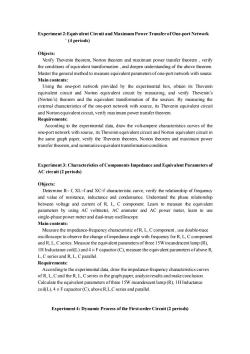
Experiment 2:Equivalent Circuit and Maximum Power Transfer of One-port Network (4 periods) Objects: Verify Thevenin theorem,Norton theorem and maximum power transfer theorem,verify the conditions of equivalent transformation,and deepen understanding of the above theorem Master the general method to measure equivalent network with sour Main contents Using the one-port network provided by the experimental box,obtain its Thevenin equivalent circuit and Norton equivalent circuit by measuring.and verify Thevenin's (Norton's)theorem and the equivalent transformation of the sources.By measuring the extemal characteristics of the one-port network with source,its Thevenin equivalent circuit Requirements: According to the experimental data,draw the volt-ampere characteristics curves of the one-port network with source,its Thevenin equivalent circuit and Norton equivalent circuit in the same graph paper,verify the Thevenin theorem,Norton theorem and maximum power ransfer the and summarizeequivalent tran ondition Experiment 3:Characteristics of Components Impedance and Equivalent Parameters of AC cireuit (2 periods) Objects: Dermine Rf XLf and XCf characteristic curve,verify the relationship of frequenc and vale of resistance,inductance and.Understand the phase relationship between voltage and current of R.L C component.Leam to measure the equivalent parameters by using AC voltmeter,AC ammeter and AC power meter,kam to use single-phase power meter and dual-trace oscilloscope. Main contents: Measure the impedance-frequency characteristic,use double-race oscilloscope to observe the change of impedance angle with frequency for R,L,C component and R,L,C series.Measure the equivalent parametersofthree 15Wincandescent lamp(R), IH Inductance coil(L)and 4 uF capacitor(C).measure the equivalent parameters ofabove R L.C series and R.L,Cparallel. Requirements According to the experimental data,draw the impedance-frequency characteristics curves of R.L.Cand the R.L.Cseries in the graphpaper,analyze results and make conclusion. Calculate the equivalent parameters ofthree 15W incandescent lamp(R),IH Inductance coil(L),4F capacitor(C),above R.L,C series and parallel. Experiment 4:Dynamic Process of the First-order Circuit(2 periods)
Experiment 2:Equivalent Circuit and Maximum Power Transfer of One-port Network ` (4 periods) Objects: Verify Thevenin theorem, Norton theorem and maximum power transfer theorem , verify the conditions of equivalent transformation , and deepen understanding of the above theorem. Master the general method to measure equivalent parameters of one-port network with source. Main contents: Using the one-port network provided by the experimental box, obtain its Thevenin equivalent circuit and Norton equivalent circuit by measuring, and verify Thevenin’s (Norton’s) theorem and the equivalent transformation of the sources. By measuring the external characteristics of the one-port network with source, its Thevenin equivalent circuit and Norton equivalent circuit, verify maximum power transfer theorem. Requirements: According to the experimental data, draw the volt-ampere characteristics curves of the one-port network with source, its Thevenin equivalent circuit and Norton equivalent circuit in the same graph paper, verify the Thevenin theorem, Norton theorem and maximum power transfer theorem, and summarize equivalent transformation condition. Experiment 3: Characteristics of Components Impedance and Equivalent Parameters of AC circuit (2 periods) Objects: Determine R~ f, XL~f and XC~f characteristic curve, verify the relationship of frequency and value of resistance, inductance and condensance. Understand the phase relationship between voltage and current of R, L, C component. Learn to measure the equivalent parameters by using AC voltmeter, AC ammeter and AC power meter, learn to use single-phase power meter and dual-trace oscilloscope. Main contents: Measure the impedance-frequency characteristic of R, L, C component , use double-trace oscilloscope to observe the change of impedance angle with frequency for R, L, C component and R, L, C series. Measure the equivalent parameters of three 15W incandescent lamp (R), 1H Inductance coil(L) and 4μF capacitor (C), measure the equivalent parameters of above R, L, C series and R, L, C parallel. Requirements: According to the experimental data, draw the impedance-frequency characteristics curves of R, L, C and the R, L, C series in the graph paper, analyze results and make conclusion. Calculate the equivalent parameters of three 15W incandescent lamp (R), 1H Inductance coil(L), 4μF capacitor (C), above R,L,C series and parallel. Experiment 4: Dynamic Process of the First-order Circuit (2 periods)
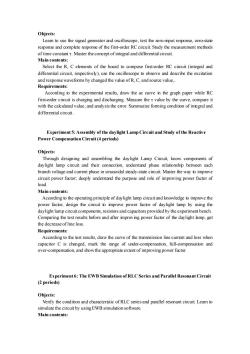
Objects: Leam to use the signal generator and oscilloscop e.test theruteoeer-state response and of the first-order RCeircuit.Study the measurement methods of time constant t.Master the concept of integral and differential circuit Main contents: Select the R,C elements of the board to compose first-order RC circuit (integral and differential circuit.respectively).us the oscilloscope to obseve and describe the excitation and response waveforms by changed the value ofR.C,and source value Requirements: According to the experimental results,draw the uc curve in the graph paper while RC first-order circuit is charging and discharging Measure thet value by the curve,compare it with the calculated value:and analysis the error.Summarize foming condition of integral and Experiment 5:Assembly of the daylight Lamp Circuit and Study of the Reactive Power Compensation Circuit(4 periods) Objeets: Through designing and assembling the daylight Lamp Circuit know components of daylight lamp circuit and their connection,understand phase relationship between each branch voltage and current phase in sinusoidal steady-state circuit Master the way to improve circuit power factor.deeply understand the purpose and role of improving power factor of load Main contents: According to the operating principle of daylight lamp circuit and knowledge to improve the power factor,design the circuit to improve power factor of daylight lamp by using the daylight lamp circuit components,resistors and capacitors provided by the experiment bench Comparing the test results before and after improving pow er factor of the daylight lamp.get the decrease of line os Requirements: According to the test results,draw the curve of the transmission line cumrent and loss when capacitor C is changed,mark the range of under-compensation,full-compensation and over-compensation,and show the appropriateextent of improving power factor. Experiment 6:The EWB Simulation of RLC Series and Parallel Resonant Circuit (2 periods) Objects: Verifyhe and characteristic of RLCseries and parallel resonant ciruit Lear to Main contents:
Objects: Learn to use the signal generator and oscilloscope, test the zero-input response, zero-state response and complete response of the first-order RC circuit. Study the measurement methods of time constant . Master the concept of integral and differential circuit. Main contents: Select the R, C elements of the board to compose first-order RC circuit (integral and differential circuit, respectively), use the oscilloscope to observe and describe the excitation and response waveforms by changed the value of R, C, and source value,. Requirements: According to the experimental results, draw the uc curve in the graph paper while RC first-order circuit is charging and discharging. Measure the value by the curve, compare it with the calculated value; and analysis the error. Summarize forming condition of integral and differential circuit . Experiment 5: Assembly of the daylight Lamp Circuit and Study of the Reactive Power Compensation Circuit (4 periods) Objects: Through designing and assembling the daylight Lamp Circuit, know components of daylight lamp circuit and their connection, understand phase relationship between each branch voltage and current phase in sinusoidal steady-state circuit. Master the way to improve circuit power factor; deeply understand the purpose and role of improving power factor of load. Main contents: According to the operating principle of daylight lamp circuit and knowledge to improve the power factor, design the circuit to improve power factor of daylight lamp by using the daylight lamp circuit components,resistors and capacitors provided by the experiment bench. Comparing the test results before and after improving power factor of the daylight lamp, get the decrease of line loss. Requirements: According to the test results, draw the curve of the transmission line current and loss when capacitor C is changed, mark the range of under-compensation, full-compensation and over-compensation, and show the appropriate extent of improving power factor. Experiment 6: The EWB Simulation of RLC Series and Parallel Resonant Circuit (2 periods) Objects: Verify the condition and characteristic of RLC series and parallel resonant circuit. Learn to simulate the circuit by using EWB simulation software. Main contents:
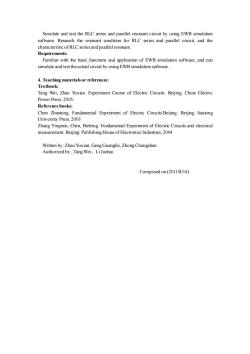
simulate and test the rlc series and parallel resonant circuit by using ewB simulation sofware.Research RICries and parallelr and he characteristic of RLCseriesand parallel resonant. Requirements: Familiar with the basic functions and application of EWB simulation software,and can simulate and test the actual circuit by using EWB simulation software. 4.Teaching materials or references Textbook: Tang Wei,Zhao Yuxian.Experiment Course of Electric Circuits.Beijing:China Electric Power Press,2005. Reference books: Chen Zhantong Fundamental Experiment of Electric Circuits Beijing:Beijing Jiaotong University Press,2003 Zhang Yingmin.Chen.Binbing Fundamental Experiment of Electric Circuits and electrical measurement.Beijing:Publishing House of Electronics Industries,2004 Written by:Zhao Yuxian,Ge eng Guan ngfei,Zhong Chongshan Authorized by:,Tang Wei.LiJunhu Composed on(2011/8/14)
Simulate and test the RLC series and parallel resonant circuit by using EWB simulation software. Research the resonant condition for RLC series and parallel circuit, and the characteristic of RLC series and parallel resonant. Requirements: Familiar with the basic functions and application of EWB simulation software, and can simulate and test the actual circuit by using EWB simulation software. 4. Teaching materials or references: Textbook: Tang Wei, Zhao Yuxian. Experiment Course of Electric Circuits. Beijing: China Electric Power Press, 2005. Reference books: Chen Zhantong. Fundamental Experiment of Electric Circuits.Beijing: Beijing Jiaotong University Press, 2003 Zhang Yingmin, Chen, Binbing. Fundamental Experiment of Electric Circuits and electrical measurement. Beijing: Publishing House of Electronics Industries, 2004 Written by: Zhao Yuxian, Geng Guangfei, Zhong Chongshan Authorized by:, Tang Wei,Li Junhui Composed on (2011/8/14)
按次数下载不扣除下载券;
注册用户24小时内重复下载只扣除一次;
顺序:VIP每日次数-->可用次数-->下载券;
- 《电路》课程教学大纲 Electric Circuit B.doc
- 《电路》课程教学大纲 Electric Circuit A.doc
- 《单片机原理与应用》课程教学课件(PPT讲稿)第3章 8051指令系统与编程基础.ppt
- 《单片机原理与应用》课程教学课件(PPT讲稿)第2章 AT89S51单片机硬件结构(1/2).ppt
- 《单片机原理与应用》课程教学课件(PPT讲稿)第2章 AT89S51单片机硬件结构(2/2).ppt
- 《单片机原理与应用》课程教学课件(PPT讲稿)第4章 AT89S52单片机的中断系统(1/2).ppt
- 《单片机原理与应用》课程教学课件(PPT讲稿)第5章 AT89S52单片机的定时器计数器(1/2).ppt
- 《单片机原理与应用》课程教学课件(PPT讲稿)第4章 AT89S52单片机的中断系统(2/2).ppt
- 《单片机原理与应用》课程教学课件(PPT讲稿)第5章 AT89S52单片机的定时器计数器(2/2).ppt
- 《单片机原理与应用》课程教学课件(PPT讲稿)第6章 AT89S52单片机的串行口(1/2).ppt
- 《单片机原理与应用》课程教学课件(PPT讲稿)第6章 AT89S52单片机的串行口(2/2).ppt
- 《单片机原理与应用》课程教学课件(PPT讲稿)ADDA电机(AT89S51单片机与DAC的接口).pptx
- 《单片机原理与应用》课程教学课件(PPT讲稿)DS18B20总线扩展技术.pptx
- 《单片机原理与应用》课程教学资源(学习资料)DS18B20测温头文件使用方法.docx
- 《单片机原理与应用》课程教学资源(授课教案)单片机定时/计数器模块.doc
- 《单片机原理与应用》课程教学资源(授课教案)AT89S52单片机的硬件组成、单片机的引脚功能(一).docx
- 《单片机原理与应用》课程教学资源(授课教案)3.7 8051汇编语言程序设计基础、3.8 汇编语言程序设计举例Keilc程序设计.docx
- 《单片机原理与应用》课程教学资源(授课教案)3.4 8051指令系统分类介绍、C语言中相关编程结构.docx
- 《单片机原理与应用》课程教学资源(授课教案)3.1 指令系统概述 3.2 指令格式 3.3 指令寻址方式 3.4 指令分类.docx
- 《单片机原理与应用》课程教学资源(授课教案)AT89S52单片机的硬件组成、单片机的引脚功能(二).docx
- 《电路》课程实验教学大纲 Experiment of Electric Circuit B.doc
- 《电路》课程教学资源(实验指导)实验1 元件伏安特性.doc
- 《电路》课程教学资源(实验指导)实验5 RLC元件阻抗特性及交流等效参数的测定.doc
- 《电路》课程教学资源(实验指导)实验3 直流电路基本定理综合实验.doc
- 《电路》课程教学资源(实验指导)实验2 电源等效变换戴维南定理.doc
- 《电路》课程教学资源(实验指导)实验4 电路过渡过程的研究.doc
- 《电路》课程教学资源(实验指导)实验7 RLC串联谐振电路的研究.doc
- 《电路》课程教学资源(实验指导)实验6 日光灯电路及功率因数的提高.doc
- 《电路》课程教学资源(实验指导)实验8 RC选频网络特性的测试.doc
- 《电路》课程教学资源(实验指导)实验9 单相电度表的校验.doc
- 《电路》课程教学资源(实验指导)实验11 三相电路综合实验.doc
- 《电路》课程教学资源(实验指导)实验13 电阻温度计的制作.doc
- 《电路》课程教学资源(实验指导)实验12 二端口网络参数的测定.doc
- 《电路》课程教学资源(实验指导)实验14 运算放大器的应用.doc
- 《电路》课程教学资源(实验指导)实验10 互感与变压器.doc
- 《电路》课程教学资源(实验指导)实验15 移相器的设计与测试.doc
- 《电路》课程教学资源(实验指导)实验16 负阻抗变换器的制作和应用.doc
- 《电路》课程教学资源(实验指导)实验17 RC一阶电路动态特性的仿真.doc
- 《电路》课程教学资源(实验指导)实验18 RLC串联谐振电路的仿真.doc
- 《电路》课程教学资源(实验指导)实验19 非正弦周期信号电路的仿真.doc
